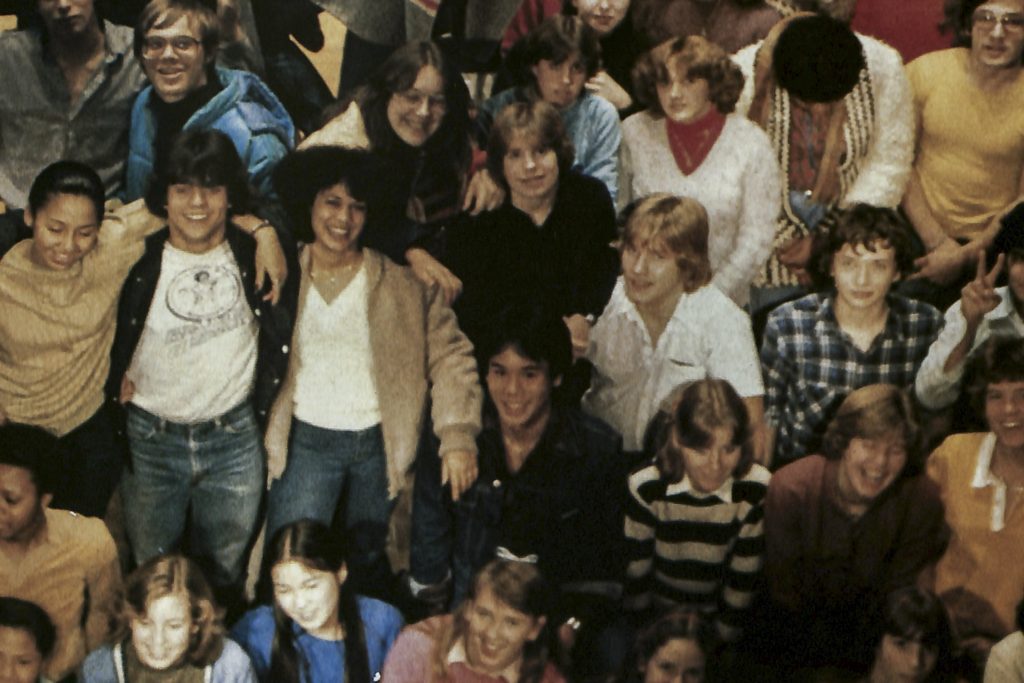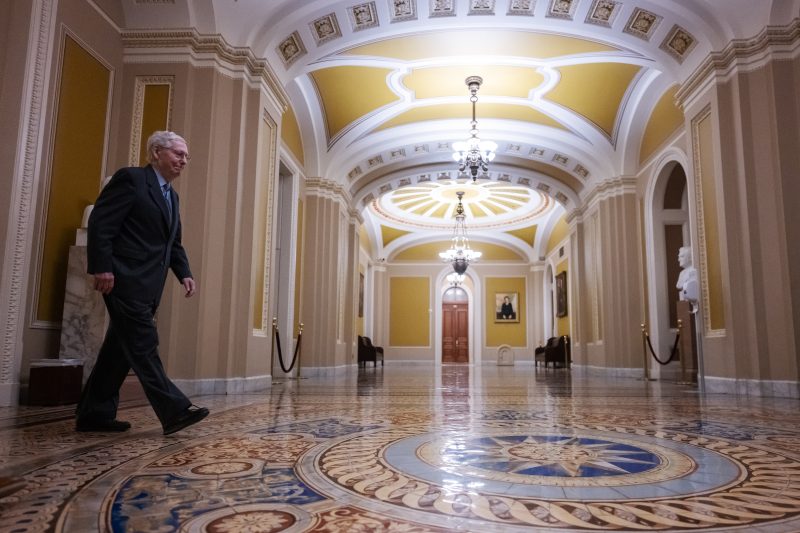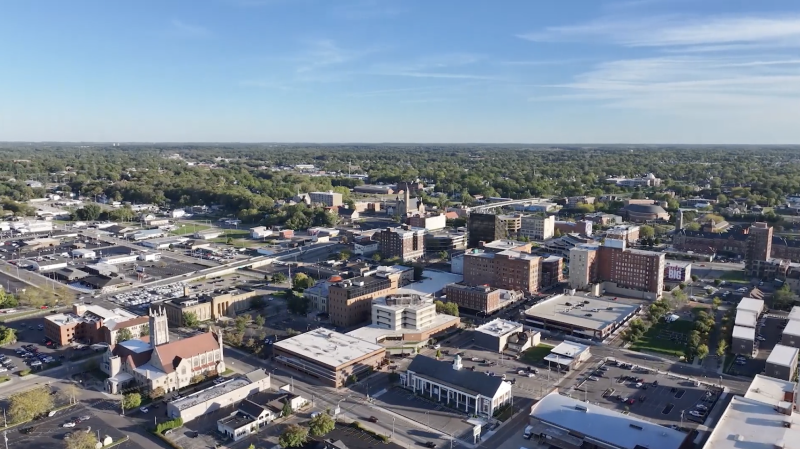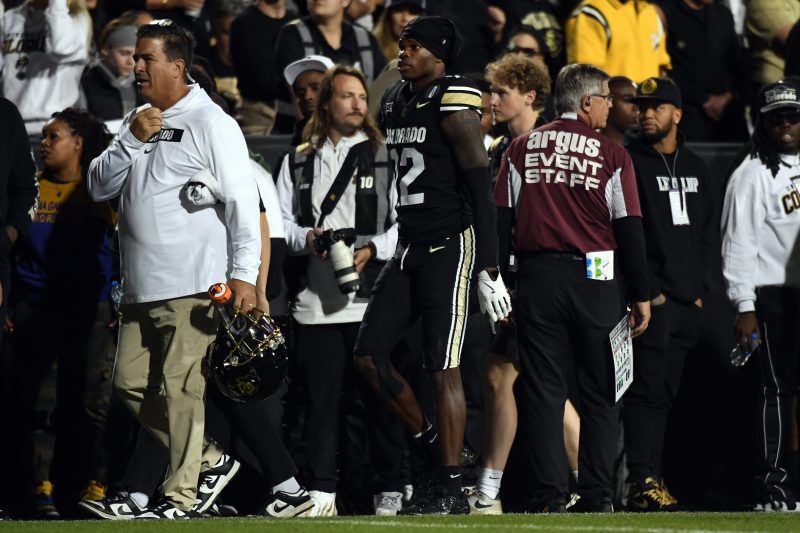These five tumultuous years in Montreal shaped Kamala Harris

A photo of Kamala Harris, middle row and third from the left with tan jacket and white v-neck shirt, from the 1981 yearbook from Westmount High School in Montreal, Canada. (Westmount High School)
MONTREAL — Kamala Harris was just starting her freshman year at a high school in Quebec when, as one of her classmates recalled, “all hell broke loose.”
After years of deepening conflict over the French-speaking majority’s treatment, a political party advocating political separation from Canada had recently taken power. Tens of thousands of English-speaking families fled as stringent new language restrictions took effect.
In the fall of 1978, everything boiled over inside Westmount High School on the outskirts of downtown Montreal. As students clashed over the political turmoil, the once primarily White and wealthy school was changing dramatically amid an influx of Black, lower-income students, including those driven to enroll when their own English-language schools suddenly were slated for closure.
Harris, a Black and Indian American expat who had left California for Canada 18 months earlier, found herself a target.
“She was bullied to a degree,” said Westmount classmate Jamie Ward, who declined to further detail what she described as racist remarks directed at Harris. “I would never repeat that. Myself being biracial, it’s harmful and it’s hurtful.”
Throughout her political career — as San Francisco district attorney, California attorney general, U.S. senator, vice president and now Democratic presidential nominee — Harris has rarely mentioned the five years she spent in Canada, between ages 12 and 17. Her memoir, “The Truths We Hold,” carries the subtitle “An American Journey,” and in it she describes her time in another country in a little more than one page. She said in her Democratic National Convention speech that she had moved “to Illinois, to Wisconsin and wherever our parents’ jobs took us,” but did not mention living in Canada. Harris declined an interview request, and her campaign declined to respond to a list of questions submitted for this article.
But her little-examined Canadian journey, as much as any period of her life, profoundly shaped her path, from becoming a prosecutor to accepting the nomination for president, according to interviews with more than two dozen classmates, teachers and others who knew her in Montreal.
Daily life in the Montreal of the late 1970s and early 1980s vividly showed Harris the real-world consequences of deep political division, while the eruptions of conflict at her high school drove home the reality of racism she would face as a biracial woman. Harris honed her early political instincts as she navigated high school bullies and a roiling political atmosphere, emerging, classmates say, as a student confident and popular across racial lines.
While many of her former classmates say they understand that Harris may feel it is politically unhelpful to talk about the time she spent in Canada, they also say there’s no doubt that those years are crucial to understanding the woman seeking the presidency.
Indeed, one of the most profound events in Harris’s early life, by her own account, came in Montreal when a high school friend confided that she was being molested. Harris insisted that Wanda Kagan move into her home, and later said the incident led her to become a prosecutor.
“It was at a pivotal point in my life that made a difference,” Kagan said in an interview of the help Harris gave her. And Kagan said navigating the challenges at Westmount “helped in building the character and the person that she is now, to be able to work with so many different people.”
A unique opportunity
Harris was born in Oakland, Calif., and spent much of her early life in nearby Berkeley, where her mother, Shyamala Gopalan, had moved from India to study at the University of California, eventually becoming a scientist at the UC Berkeley Cancer Research Laboratory. Her father, Donald Harris, is an economist from Jamaica.
Her parents divorced in 1971, and six years later, her mother announced that Kamala and her younger sister, Maya, would move with her to Montreal. Harris wrote in her memoir that the thought of moving in the middle of the school year “to a French-speaking foreign city covered in twelve feet of snow was distressing, to say the least.” In Harris’s telling, her mother could not pass up a “unique opportunity” to teach at McGill University and conduct research at Jewish General Hospital.
The reason for the sudden departure went deeper, however, according to her mother’s close friend and fellow scientist Mina Bissell.
In effect, Bissell said, “she got fired” from the Berkeley position in a clash with a male chauvinist supervisor over credit for her research. Bissell stressed that it had nothing to do with the quality of her work. Rather, the supervisor thought the research “was important enough that he would give the job to himself rather than to Shyamala. So he fired her.” The supervisor and Shyamala are both deceased.
Professor Russell Vance, the lab director today, said the institution does not have records going back to Shyamala’s time. While he had never heard of the incident, he said, “I do think women scientists and scientists of color did face a lot of discrimination in those days.”
Shyamala Harris found sanctuary at Montreal’s Jewish General Hospital, which had been created in the 1930s after doctors went on strike elsewhere over the hiring of a Jewish intern. Shyamala would probably have faced sexist and racist blowback at other hospitals, where the view would have been “What is this Indian woman doing here?” said Michael Pollak, a doctor who collaborated with her at Jewish General, which emphasized diverse hiring. “It was hyper-accepting. And she wanted to do her cancer research more than she wanted to pick a battle. She was strategic. Her battle was with cancer.”
Working at the lab, Shyamala sometimes would bring along Kamala, who has said her “first job” was washing pipettes at one of her mother’s labs after school and on weekends.
“Whatever happened in California interfered with her professional aspirations,” Pollak said of Harris’s mother. “It was important enough to justify this dislocation, a trip to the north with the two young daughters.”
Now the challenge was to find a way for her daughters to fit in during a time of extraordinary political and social upheaval in the politics of Quebec.
Bombs and snipers
In the years before the Harris family arrived in Montreal, the Westmount neighborhood where they would settle was rocked by bombings, protests and massive rallies. At the root of the tumult was a bitter division dating to Britain taking over French-founded Quebec in the 18th century and then discriminating against the Francophone majority.
In the late 1960s, radical groups demanding a sovereign Quebec bombed the mayor’s house and the stock exchange. In 1970, they set off five bombs around Westmount. Snipers were stationed on rooftops to protect businesses run by English speakers, and the military patrolled the streets.
One of Harris’s schoolmates, Nicholas Simons, said that in his youth, “I didn’t know what a fire drill was, but I knew what a bomb-threat drill was.”
Most of the violence had ebbed by the time the Harris family moved in, but a political earthquake had just struck when the party of the French-speaking majority won the 1976 election. The Parti Québécois soon passed the Charter of the French Language, which made French the official language of business and signage, and enacted measures designed to restrict the ability of students to attend English-speaking schools.
The new rules added to divisions between the 80 percent of Quebec’s 6 million residents who spoke French and were predominantly Catholic and the largely Protestant English-speaking minority, whose numbers were being bolstered by immigrants from Caribbean countries and elsewhere.
When Harris arrived as a 12-year-old, she was not really in either world — but she was deeply affected by the political change.
Harris was already homesick for California, and “it was made worse when my mother told us that she wanted us to learn the language, so she was enrolling us in a neighborhood school for native French speakers,” Harris wrote. The school, which she attended in early 1977, was called Notre-Dame-des-Neiges, for Our Lady of the Snows. Harris found it so difficult that she persuaded her mother to let her transfer to a school where she could learn in English — Fine Arts Core Education — for the 1977-78 academic year.
The new law narrowed her educational options as nearly 100,000 English-speaking residents fled Quebec in 1977, according to a New York Times report. By the account of several of Harris’s friends, the English-oriented high school she was likely to attend in the fall of 1978 was among many slated for closure amid that upheaval. Classmate Ariela Katz recalled that she and Harris and some others “slid just under the wire” and were admitted into one of the remaining English-speaking high schools.
As a result, Harris ended up at Westmount High in an area that one classmate described as “the Beverly Hills of Montreal,” with mansions and luxurious apartments on leafy thoroughfares. The school was undergoing de facto integration. When teacher David Bracegirdle had started a few years earlier, he’d watched as limousines pulled up and dropped off students at the mostly White school.
As Harris arrived, Black students, many from nearby Caribbean-dominated communities, were on the way to becoming about 40 percent of the roughly 1,000 students, making the school among the most diverse in Quebec, according to former students and teachers. Westmount was so crowded that some classes were held on the auditorium stage, according to Bracegirdle.
As a freshman, Harris found herself plunged into a school navigating deep changes, an outsider in a tumultuous mix of backgrounds and languages. “When she arrived from California, she was very reserved,” Ward said. “It was an adjustment for her because Americans in that part of the world at that time, it was very heavy with the French.”
Joel Margoles, a Harris classmate and editor of the Westmount yearbook, said the school was clearly divided between those who had been in French immersion programs starting in kindergarten and those, like Harris, who had not. The French-immersion students “tended to get better teachers and better classes and were more the student leaders,” Margoles said. “And Kamala not coming from the area, she would have been kind of disadvantaged from the start in the way the school was set up.”
Kristian Gravenor, who was one year ahead of Harris at Westmount, said English-speaking residents lived in a “kind of fear.” While some classmates recall occasionally violent clashes, Gravenor said it was more psychological tension.
“It was in your mind. It was a really terrible time for being English, and it would have been weird to move to Montreal,” as Harris had done, “because at that time people were moving away.”
As Gravenor recalled it, the school was dominated by English speakers whom Francophones called “White Rhodesians,” a reference to the White minority that ruled the African nation, today’s Zimbabwe. “We were seen as repressing the French, so we felt really targeted,” he said. “The whole thing was falling apart.”
“We just didn’t feel welcome,” said Margoles, referring to how Anglophones felt put upon by the Francophones.
On top of the language divisions, the newly diverse Westmount also faced a racial reckoning.
Margoles recalled that “the White students and Black students did not mix,” a view echoed by other students as well as teachers. Margoles said he didn’t see “inherent racism, but it was definitely a separation. I never thought there was hostility, but it also was never camaraderie or mixing.”
Of Harris, he said, “I could easily imagine she felt not included.”
Katz recalled watching the racism faced by her boyfriend at the time, who was biracial. “If you went to a party and some people started drinking, the rich kids from Upper Westmount would start to say things about him that he should not have been countenancing.”
Harris surrounded herself with a small group of allies, mainly those with Black and biracial backgrounds, according to classmates. Katz said he did not see her hanging out regularly with White student leaders.
Deborah Boykin, who was a year behind Harris and also is biracial, recalled that their time at Westmount may have to American eyes “looked segregated because all of the Black kids come together, all of the White kids come together. But we didn’t know … we just didn’t have the same history as the U.S. — we didn’t have slavery.”
In their group of friends, Boykin said, Harris’s mother stood out as a successful scientist while most other students’ families “were on welfare, on government assistance.”
Undergirding everything at the high school was the growing push to effectively separate Quebec from Canada.
A divisive vote
In May 1980, when Harris was in 10th grade, the province prepared to vote on whether Quebec should gain political sovereignty — giving it the right to enact its own laws — while retaining economic ties to Canada. The city was plastered with posters that said “Oui” or “Non,” with the vast majority of those in Westmount opposing the measure.
Derek Leebosh, a Westmount classmate, said the political wars would have played out before Harris.
“All of a sudden she was a minority within a minority within a minority,” Leebosh said. “You’re a Black minority within the English. The English is a minority community within Francophone Quebec, which is a minority in Anglophone North America. And during this period, language laws are being passed. It’s very emotional; there’s lots of demonstrations. That’s all going on in the background.”
Students held heated meetings at the school, with the vast majority of students against separating from Canada.
Katz, an American who had lived in Israel before moving to Canada, was one of the only students who wore a “Oui” button in favor of separatism. “The idea that an oppressed [group] would finally rise up and say, well, 80 percent of the province speaks French, we should be speaking French, did not seem surprising to me,” said Katz, now a professor of architecture in Paris.
But it made little sense to most of Harris’s classmates. None recalled whether Harris was ever openly for or against the measure, which because of her age and citizenship, she would not have been able to vote on.
“The tension was extremely high,” Ward remembered. In the end, the separation measure lost, 60 percent to 40 percent, but powerful efforts to elevate French continued, as did the exodus of English-speakers.
Harris was shaped by the pressures at the school, her classmates said, and they noticed her transformation. Channeling her parents — who had “talked about apartheid, about African decolonization … and about the history of racism in America,” as Harris later wrote in her memoir — Harris became a student of Montreal’s cultural stew. She began asking questions about where she fit in, and how Montrealers dealt with divisions. “She was very, very interested in diversity in Montreal,” Ward said.
Students were also adjusting to life in a newly diverse school, and many came to appreciate the change, said Anne Peacock, who taught Harris in her enriched English class. Peacock recalled asking classes about the change.
“The privileged kids said that the inclusive education was the best thing that could possibly have happened to them,” Peacock said. “And I think that’s hugely important.”
As Harris’s comfort level increased, she told classmates that her main interests were as an entertainer. Brian Israel, who took drama class with her, recalled doing a fashion show with her, as well as a photo shoot for a blue jeans company, which resulted in an advertisement being placed around Montreal.
“I definitely believed she would go that route of entertaining, acting, singing, dancing,” said Israel, who today is an officer with the D.C. police and often drives by the vice president’s residence.
Katz recalled Harris becoming “very popular, and very cool — a very lively kind of leader” at the school.
Over time, classmates said, Harris invited them to her home and began to feel more confident about how to navigate the political and social tensions.
One of those invitations would lead to an experience that Harris later said altered the course of her life.
A path-changing moment
Harris had gotten to know Wanda Kagan, who is Black, at a Black-oriented community center before either ended up at Westmount, where they became close friends. Harris would bring Kagan lunch at school “because I often did not have one,” Kagan told The Washington Post.
One day, as Harris later recounted in her convention speech, she noted that Kagan was “sad at school, and there were times she didn’t want to go home.” Kagan confided in her “that she was being sexually abused by her stepfather,” Harris said.
Kagan, who spoke to The Post in interviews and emails, said the moment recounted by Harris happened in 11th grade. She recalled that “I came to school one day and this particular day Kamala asked me how come I didn’t really seem myself. I didn’t tell her at first. I was just like, I have a lot going on. … I eventually blurted it out.”
Harris, in her convention speech, said that “I immediately told her she had to come stay with us, and she did.”
The Harris family at this time was living on the second floor of a duplex building on fashionable Grosvenor Avenue, about a 30-minute walk from Westmount High. Kagan recalls thinking during her time living at the Harris home: “I get to make my own good lunches now.”
Kagan and Harris studied and played music together. At dinner, Kagan would marvel at the array of spices displayed in glass jars and used to prepare meals, far from her knowledge of salt and pepper.
Harris said learning about her friend’s molestation “is one of the reasons I became a prosecutor, to protect people like Wanda.”
The Harris campaign and Kagan have not disclosed her stepfather’s name, whether he is living, or whether charges were filed.
A mutual friend of Harris and Kagan’s told The Post she remembered Kagan discussing the matter at the time and confirmed that Kagan lived at Harris’s home for some time. It was not possible to independently verify details about the alleged molestation. The Post left messages seeking comment from an individual whose name and city match the stepfather, but could not be certain it was the same person. He did not respond.
Harris did not mention Kagan or the molestation incident in her memoir, nor that it inspired her to be a prosecutor. She wrote in the 2019 book that she was inspired to be a lawyer by her heroes in the civil rights movement. Harris mentioned Kagan’s stay at her home during the 2020 campaign, but mistakenly said the incident involved Kagan’s father, rather than her stepfather.
In her convention speech in August accepting the Democratic nomination, Harris prominently featured her experience with Kagan — but did not mention that the incident occurred when she was living in Canada.
The campaign produced a biographical video for the convention that featured Harris and Kagan telling their story, which the narrator, actor Morgan Freeman, said was a moment “that changed Kamala Harris’s destiny” by convincing her to become a prosecutor, lighting “the fire within.”
Graduation
By the time Harris completed her years at Westmount, she had transformed from the reserved Californian into one of the school’s more outgoing personalities, remembered for greeting anyone who walked by.
For Harris, her education came in what was taught in her classes, but perhaps even more in the political tensions around her. Still, classmates said they had no inkling of her political future.
“She was an impressive girl — kind, a great singer and comedian,” said Richard Carr, who added that he had a crush on her. “She was a total clown, and usually the one who was actually instigating the pranks on her friends.”
As Harris’s third and final year at Westmount — the equivalent of 11th grade in the United States — came to a close, Carr performed with her in the Purple and White Review, doing a rendition of the Kool & the Gang song “Celebration.”
For graduation, Harris invited her father to join the family in Montreal.
“I still wanted them both to be there for me,” she wrote in her memoir. When Donald Harris showed up, Kamala waited for her mother to arrive, but she was “nowhere to be found.” Harris wrote that she wondered whether her mother would decline to come because her father was in the audience.
Finally, Shyamala entered through the back door, wearing a bright-red dress and heels instead of the jeans and tennis shoes she usually wore to the lab. Shyamala would live in Montreal for another 10 years, for a total of 15.
Harris spent one more year in Montreal, attending Vanier College for the U.S. equivalent of 12th grade. Ward remembers they both felt it was time to leave Montreal. Ward felt the city “was just too racially divided” and she returned to her native New York City.
Harris, who had returned to the United States every summer and for holidays, and who years earlier had been bused to school in California as part of a desegregation plan, now contemplated her future.
Harris later wrote that there was no question she wanted to return to the United States for college. She left Quebec and headed to Howard University, the historically Black institution that her aunt had attended and that Harris had long admired. The Washington campus was a world away from the racial, ethnic and cultural divisions she had seen so often in Quebec.
As she settled into a seat at Cramton Auditorium for an orientation in 1982, Harris recalled in her memoir, she realized that everyone looked like her. “This is heaven!” she wrote. The message she got was that “we were young, gifted, and Black, and we shouldn’t let anything get in the way of our success.”
Aaron Schaffer in Washington contributed to this report.







